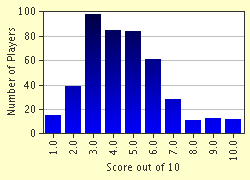Quiz Answer Key and Fun Facts
1. Countries: With a July 2004 population estimated at 775,927, this country's median life expectancy of 77.46 years and 97.6% literacy rate for those over age 15 was better than that of the US.
2. Cheers! What drink is made from 1 oz Apricot brandy, 1 oz Amaretto and 3 oz Orange juice, shaken then strained over ice?
3. Artists: honored with a series of stamps in the United States, this artist was a close friend of Degas. This artist's works normally portrayed everyday life, especially mothers and children.
4. Sue Grafton has been writing a series of crime novels with an alphabetic theme. What is the title of the third book in the series?
5. Music, music, music: This French composer's best-known piece celebrates Spain....
6. Old occupations: What did a carner do?
7. Here's one to keep your tail wagging! This friendly dog is both fearless and affectionate. The moderate-length, silky coat has some long 'feathering', and often there is what is called a 'Blenheim spot' between the ears.
8. Starry, starry night: This constellation was named for the father of Andromeda. It's alpha star is Alderamin. Northern hemisphere, folks...
9. Mmmm... spicy! This spice is related to parsley. It "is probably one of the first spices used by mankind, having been known as early as 5000 BC. Sanskrit writings dating from about 1500 BC also spoke of it." (culinarycafe.com) It is used in Asian cuisine, gin, sausages and, believe it or not, cigarettes.
10. A pocket full of posies: This flower, the Osteospermum hyoseroides, has 2 to 4 inch yellow flowers tipped with violet.
Source: Author
cariM0952
This quiz was reviewed by FunTrivia editor
ozzz2002 before going online.
Any errors found in FunTrivia content are routinely corrected through our feedback system.

